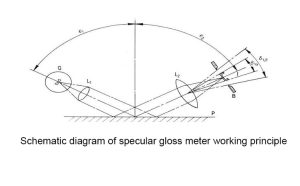D523-08 Standard Test Method for Specular Gloss

D523-08 Standard Test Method for Specular Gloss
This standard is issued under the fixed designation D523; the number immediately following the designation indicates the year of original adoption or, in the case of revision, the year of last revision. A number in parentheses indicates the year of last reapproval . A superscripl epsilon indicates an editorial change since the last revision or reapproval. This standard has been approved for use by agencies of the Department of Defense .
1.Scope Of D523-08
- This test method covers the measurement of the specular gloss of nonmetallic specimens for gloss meter geometries of 60, 20, and 85 (1-7)
- The values stated in inch-pound units are to be regarded as standard. The values given in parentheses are mathematical conversions to Sl units that are provided for information only and are not considered standard.
- This standard does not purport to address a of the safety concerns, if any, associated with its use. It is the responsibility of the user of this standard to establish appropriate safety and health practices and determine the applicability of regulatory limitations prior to use.
2.Referenced Documents
ASTM Standards:
- D 823 Practices for Producing Films of Uniform Thickness of Paint, Varnish, and Related Products on Test Panels
- D 3964 Practice for Selection of Coating Specimens for Appearance Measurements
- D 3980 Practice for Inter laboratory Testing of Paint and Related Materials
- D4039 Test Method for Reflection Haze of High-Gloss Surfaces
- E 97 Test Method for Directional Reflectance Factor,45-Deg 0-Deg, of Opaque Specimens by Broad-Band Filter Reflectometry
- E 430 Test Methods for Measurement of Gloss of High Gloss Surfaces by Abridged Goniophotometry
3. Terminology
Definitions:
- relative luminous reflectance factor, n-the ratio of the luminous flux reflected from a specimen to the flux reflected from a standard surface under the same geometric conditions. For the purpose of measuring specular gloss,the standard surface is polished glass.
- specular gloss, n-the relative luminous reflectance factor of a specimen in the mirror direction.
4. Summary of Test Method
4.1 Measurements are made with 60, 20, or 85 geometry. The geometry of angles and apertures is chosen so that these procedures may be used as follows:
4.1.1 The 60 geometry is used for intercomparing most specimens and for determining when the 200 geometry may be more applicable.
4.1.2 The 20 geometry is advantageous for comparing specimens having 60gloss values higher than 70.
4.1.3 The 85 geometry is used for comparing specimens for sheen or near-grazing shininess. It is most frequently applied when specimens have 60gloss values lower than 10.
5.Significance and Use OF D523-08
5.1 Gloss is associated with the capacity of a surface to reflect more light in directions close to the specular than in others. Measurements by this test method correlate with visual observations of surface shininess made at roughly the corresponding angles.
5.1.1 Measured gloss ratings by this test method are obtained by comparing the specular reflectance from the specimen to that from a black gloss standard. Since specular reflectance depends also on the surface refractive index of the specimen, the measured gloss ratings change as the surface refractive index changes.In obtaining the visual gloss ratings, however, it is customary to compare the specular reflectances of two specimens having similar surface refractive indices.
5.2 Other visual aspects of surface appearance, such as distinctness of reflected images, reflection haze, and texture, are frequently involved in the assessment of gloss.
Test Method E 430 includes techniques for the measurement of both distinctness-of-image gloss and reflection haze. Test method D4039 provides an alternative procedure for measuring reflection haze.
5.3 Little information about the relation of numerical to perceptual intervals of specular gloss has been published. However,in many applications the gloss scales of this test method hae provided instrumental scaling of coated specimens that have agreed well with visual scaling.
5.4 when specimens differing widely in perceived gloss or color,or both ,are compared,nonlinearity may be encountered in the relationship between visual gloss difference ratings and instrumental gloss reading differences.
D523-08 Standard Test Method for Specular Gloss
